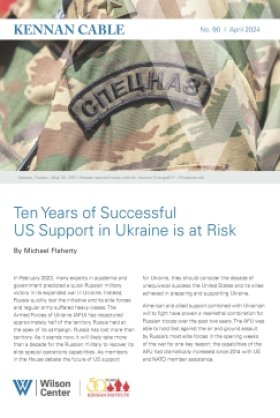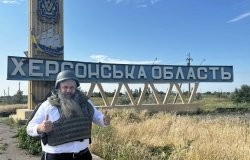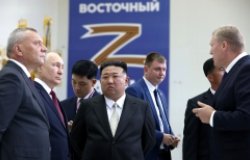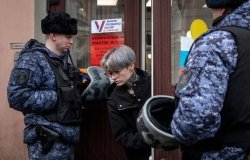Moscow 1941: A City and Its People at War
The "first defeat of the German Army came in the Battle of Moscow in 1941," said Rodric Braithwaite, former British Ambassador to the Soviet Union/Russian Federation, and Public Policy Scholar, Woodrow Wilson Center during a 13 June 2005 lecture at the Kennan Institute. In terms of the numbers involved, this was the largest battle in World War II, and, according to one estimate, in that single battle Russian losses equaled the combined number of Americans, British, and French who died during all of World War II. Braithwaite went on to describe the situation in Moscow during the battle, drawing on research for a forthcoming book on Moscow in 1941.
In June 1941, the Soviet Union had the world's largest army and air force, more tanks than the rest of the world combined, and Stalin had an immense amount of intelligence indicating the likelihood of a German attack. The Soviet army was nevertheless severely defeated in the initial battles, in part because the Soviets were halfway through a massive program of re-equipment and expansion, in part because the Soviet army was still demoralized from the prewar purges, and in part because of Stalin's own severe misjudgments of Germany's intentions. In the first six months of the war, about 2.5 million Soviet soldiers were taken prisoner, nearly 700,000 of them in the first weeks of the Battle of Moscow. About 2 million prisoners had died by the end of the year from German neglect.
Braithwaite described how German military leaders had seriously underestimated the Soviets, assuming that German forces would defeat the Soviet army as quickly as they had defeated the French army a year earlier. It would be a matter of weeks, they calculated, before they got to Moscow. Instead, they faced substantial and increasing resistance, and they found themselves in a protracted war for which they had in the end neither the equipment nor the resources.
The people of Moscow responded to the initial German attack with a flood of volunteers to join the army. Volunteers came from the intelligentsia, from factories, and from schools. They included substantial numbers of women, who served as everything from nurses to pilots to snipers. Twelve volunteer divisions were formed, and they suffered such large losses in the Battle of Moscow that five had to be disbanded. The common belief is that these volunteers were sent into the field unarmed and unprepared. Most of them did have adequate uniforms, weapons, and some training, and were little worse off than soldiers in the regular army, who in 1941 were also poorly equipped and trained.
On October 15, with the German army approaching, Stalin ordered that the government be evacuated from Moscow. Braithwaite recounted how the evacuation created a panic in the city. Factories and offices were shut down with no explanation given to employees. There were riots and looting, with some rioters calling out pro-Nazi slogans. Stalin responded by remaining in Moscow, halting the evacuation, providing workers with food and cash, and unleashing the NKVD to restore order.
Against the advice of his generals, and with the Germans little more than fifty miles from Moscow, Stalin held a military parade in Red Square on November 7 to mark the anniversary of the Bolshevik Revolution. The parade had a tremendous impact on morale in Moscow and throughout the Soviet Union. Stalin's willingness to take such a risk reflected his strength as a leader of a nation at war, Braithwaite contended, just as his failure to prepare for the German attack in June reflected his weakness. In December 1941, the Russians counter-attacked and inflicted a severe defeat on the Germans.
Living conditions in Moscow during the fall and winter of 1941 deteriorated seriously, though they were never as dire as they were during the Siege of Leningrad (1941-1944). Food supplies, sanitation, and heating were all on the verge of breakdown. Nevertheless, the cultural life of the city continued even as battles raged on the outskirts of the city.
Estimates of wartime casualties vary, partly because the information is unreliable or non-existent, and partly because both Russians and foreigners have from time to time inflated or diminished the figures for political reasons, said Braithwaite. But by any calculation, Russian losses during the war were staggering. According to one scholarly estimate, for every Britton or American who died, the Japanese lost seven people, the Germans lost 20 people, and the Russians lost 85 people. The overall casualty figure for the Soviet Union is estimated to be 9 million soldiers and 17 million civilians, not including the wounded.
"What is beyond doubt," concluded Braithwaite, "is that four-fifths of the fighting in Europe took place on the Eastern Front, and that is where the Germans suffered ninety percent of their casualties. Even after D-Day, two-thirds of the German forces were in the East. If they had not been there, they would have been in France, and there would have been no D-Day. And that is why the Russians tend to think it was they who won the war, and why I tend to think that they are right."
About the Author


Kennan Institute
The Kennan Institute is the premier US center for advanced research on Russia and Eurasia and the oldest and largest regional program at the Woodrow Wilson International Center for Scholars. The Kennan Institute is committed to improving American understanding of Russia, Ukraine, Central Asia, the Caucasus, and the surrounding region though research and exchange. Read more










